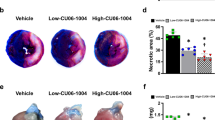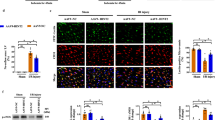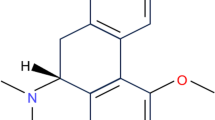Abstract
Cardiac microvascular ischemia-reperfusion (IR) injury has been a neglected topic in recent decades. In the current study, we investigated the mechanism underlying microvascular IR injury, with a focus on mitochondrial homeostasis. We also explored the protective role of tanshinone IIA (Tan IIA) in microvascular protection in the context of IR injury. Through animal studies and cell experiments, we demonstrated that IR injury mediated microvascular wall destruction, lumen stenosis, perfusion defects, and cardiac microvascular endothelial cell (CMEC) apoptosis via inducing mitochondrial damage. In contrast, Tan IIA administration had the ability to sustain CMEC viability and microvascular homeostasis, finally attenuating microvascular IR injury. Function studies have confirmed that the SIRT1/PGC1α pathway is responsible for the microvascular protection from the Tan IIA treatment. SIRT1 activation by Tan IIA sustained the mitochondrial potential, alleviated the mitochondrial pro-apoptotic factor leakage, reduced the mPTP opening, and blocked mitochondrial apoptosis, providing a survival advantage for CMECs and preserving microvascular structure and function. By comparison, inhibiting SIRT1 abrogated the beneficial effects of Tan IIA on mitochondrial function, CMEC survival, and microvascular homeostasis. Collectively, this study indicated that Tan IIA should be considered a microvascular-protective drug that alleviates acute cardiac microcirculation IR injury via activating the SIRT1/PGC1α pathway and thereby blocking mitochondrial damage.






Similar content being viewed by others
Data availability
All data generated or analyzed during this study are included in this published article.
References
Aalto AL, Mohan AK, Schwintzer L, Kupka S, Kietz C, Walczak H, Broemer M, Meinander A (2019) M1-linked ubiquitination by LUBEL is required for inflammatory responses to oral infection in Drosophila. Cell Death Differ 26:860–876. https://doi.org/10.1038/s41418-018-0164-x
Abeysuriya RG, Lockley SW, Robinson PA, Postnova S (2018) A unified model of melatonin, 6-sulfatoxymelatonin, and sleep dynamics. J Pineal Res 64:e12474. https://doi.org/10.1111/jpi.12474
Abukar Y, Ramchandra R, Hood SG, McKinley MJ, Booth LC, Yao ST, May CN (2018) Increased cardiac sympathetic nerve activity in ovine heart failure is reduced by lesion of the area postrema, but not lamina terminalis. Basic Res Cardiol 113:35. https://doi.org/10.1007/s00395-018-0695-9
Anderton H, Bandala-Sanchez E, Simpson DS, Rickard JA, Ng AP, di Rago L, Hall C, Vince JE, Silke J, Liccardi G, Feltham R (2019) RIPK1 prevents TRADD-driven, but TNFR1 independent, apoptosis during development. Cell Death Differ 26:877–889. https://doi.org/10.1038/s41418-018-0166-8
Armartmuntree N, Murata M, Techasen A, Yongvanit P, Loilome W, Namwat N, Pairojkul C, Sakonsinsiri C, Pinlaor S, Thanan R (2018) Prolonged oxidative stress down-regulates early B cell factor 1 with inhibition of its tumor suppressive function against cholangiocarcinoma genesis. Redox Biol 14:637–644. https://doi.org/10.1016/j.redox.2017.11.011
Ba X, Boldogh I (2018) 8-Oxoguanine DNA glycosylase 1: beyond repair of the oxidatively modified base lesions. Redox Biol 14:669–678. https://doi.org/10.1016/j.redox.2017.11.008
Battistelli C, Sabarese G, Santangelo L, Montaldo C, Gonzalez FJ, Tripodi M, Cicchini C (2019) The lncRNA HOTAIR transcription is controlled by HNF4alpha-induced chromatin topology modulation. Cell Death Differ 26:890–901. https://doi.org/10.1038/s41418-018-0170-z
Bittremieux M, la Rovere RM, Akl H, Martines C, Welkenhuyzen K, Dubron K, Baes M, Janssens A, Vandenberghe P, Laurenti L, Rietdorf K, Morciano G, Pinton P, Mikoshiba K, Bootman MD, Efremov DG, de Smedt H, Parys JB, Bultynck G (2019) Constitutive IP3 signaling underlies the sensitivity of B-cell cancers to the Bcl-2/IP3 receptor disruptor BIRD-2. Cell Death Differ 26:531–547. https://doi.org/10.1038/s41418-018-0142-3
Bocci M, Sjölund J, Kurzejamska E, Lindgren D, Marzouka NAD, Bartoschek M, Höglund M, Pietras K (2019) Activin receptor-like kinase 1 is associated with immune cell infiltration and regulates CLEC14A transcription in cancer. Angiogenesis 22:117–131. https://doi.org/10.1007/s10456-018-9642-5
Boga JA, Caballero B, Potes Y, Perez-Martinez Z, Reiter RJ, Vega-Naredo I, Coto-Montes A (2018) Therapeutic potential of melatonin related to its role as an autophagy regulator: a review. J Pineal Res 66:e12534. https://doi.org/10.1111/jpi.12534
Chandra M, Escalante-Alcalde D, Bhuiyan MS, Orr AW, Kevil C, Morris AJ, Nam H, Dominic P, McCarthy KJ, Miriyala S, Panchatcharam M (2018) Cardiac-specific inactivation of LPP3 in mice leads to myocardial dysfunction and heart failure. Redox Biol 14:261–271. https://doi.org/10.1016/j.redox.2017.09.015
Cheignon C, Tomas M, Bonnefont-Rousselot D, Faller P, Hureau C, Collin F (2018) Oxidative stress and the amyloid beta peptide in Alzheimer’s disease. Redox Biol 14:450–464. https://doi.org/10.1016/j.redox.2017.10.014
Chen T, Dai SH, Li X, Luo P, Zhu J, Wang YH, Fei Z, Jiang XF (2018) Sirt1-Sirt3 axis regulates human blood-brain barrier permeability in response to ischemia. Redox Biol 14:229–236. https://doi.org/10.1016/j.redox.2017.09.016
Chrifi I, Louzao-Martinez L, Brandt MM, van Dijk CGM, Bürgisser PE, Zhu C, Kros JM, Verhaar MC, Duncker DJ, Cheng C (2019) CMTM4 regulates angiogenesis by promoting cell surface recycling of VE-cadherin to endothelial adherens junctions. Angiogenesis 22:75–93. https://doi.org/10.1007/s10456-018-9638-1
Darden J, Payne LB, Zhao H, Chappell JC (2019) Excess vascular endothelial growth factor-a disrupts pericyte recruitment during blood vessel formation. Angiogenesis 22:167–183. https://doi.org/10.1007/s10456-018-9648-z
DeLeon-Pennell KY et al (2018) LXR/RXR signaling and neutrophil phenotype following myocardial infarction classify sex differences in remodeling. Basic Res Cardiol 113:40. https://doi.org/10.1007/s00395-018-0699-5
Denton D, Xu T, Dayan S, Nicolson S, Kumar S (2019) Dpp regulates autophagy-dependent midgut removal and signals to block ecdysone production. Cell Death Differ 26:763–778. https://doi.org/10.1038/s41418-018-0154-z
Edwards KS, Ashraf S, Lomax TM, Wiseman JM, Hall ME, Gava FN, Hall JE, Hosler JP, Harmancey R (2018) Uncoupling protein 3 deficiency impairs myocardial fatty acid oxidation and contractile recovery following ischemia/reperfusion. Basic Res Cardiol 113:47. https://doi.org/10.1007/s00395-018-0707-9
Erland LAE, Shukla MR, Singh AS, Murch SJ, Saxena PK (2018a) Melatonin and serotonin: mediators in the symphony of plant morphogenesis. J Pineal Res 64. https://doi.org/10.1111/jpi.12452
Erland LAE, Yasunaga A, Li ITS, Murch SJ, Saxena PK (2018b) Direct visualization of location and uptake of applied melatonin and serotonin in living tissues and their redistribution in plants in response to thermal stress. J Pineal Res 66:e12527. https://doi.org/10.1111/jpi.12527
Fan G, Zhu Y, Guo H, Wang X, Wang H, Gao X (2011) Direct vasorelaxation by a novel phytoestrogen tanshinone IIA is mediated by nongenomic action of estrogen receptor through endothelial nitric oxide synthase activation and calcium mobilization. J Cardiovasc Pharmacol 57:340–347. https://doi.org/10.1097/FJC.0b013e31820a0da1
Fan T, Pi H, Li M, Ren Z, He Z, Zhu F, Tian L, Tu M, Xie J, Liu M, Li Y, Tan M, Li G, Qing W, Reiter RJ, Yu Z, Wu H, Zhou Z (2018) Inhibiting MT2-TFE3-dependent autophagy enhances melatonin-induced apoptosis in tongue squamous cell carcinoma. J Pineal Res 64. https://doi.org/10.1111/jpi.12457
Farber G, Parks MM, Lustgarten Guahmich N, Zhang Y, Monette S, Blanchard SC, di Lorenzo A, Blobel CP (2019) ADAM10 controls the differentiation of the coronary arterial endothelium. Angiogenesis 22:237–250. https://doi.org/10.1007/s10456-018-9653-2
Feng J, Li S, Chen H (2016) Tanshinone IIA inhibits myocardial remodeling induced by pressure overload via suppressing oxidative stress and inflammation: possible role of silent information regulator 1. Eur J Pharmacol 791:632–639. https://doi.org/10.1016/j.ejphar.2016.09.041
Frank D, Vince JE (2019) Pyroptosis versus necroptosis: similarities, differences, and crosstalk. Cell Death Differ 26:99–114. https://doi.org/10.1038/s41418-018-0212-6
Fukumoto M, Kondo K, Uni K, Ishiguro T, Hayashi M, Ueda S, Mori I, Niimi K, Tashiro F, Miyazaki S, Miyazaki JI, Inagaki S, Furuyama T (2018) Tip-cell behavior is regulated by transcription factor FoxO1 under hypoxic conditions in developing mouse retinas. Angiogenesis 21:203–214. https://doi.org/10.1007/s10456-017-9588-z
Hu S, Gao Y, Zhou H, Kong F, Xiao F, Zhou P, Chen Y (2017) New insight into mitochondrial changes in vascular endothelial cells irradiated by gamma ray. Int J Radiat Biol 93:470–476. https://doi.org/10.1080/09553002.2017.1286048
Jeelani R, Maitra D, Chatzicharalampous C, Najeemuddin S, Morris RT, Abu-Soud HM (2018) Melatonin prevents hypochlorous acid-mediated cyanocobalamin destruction and cyanogen chloride generation. J Pineal Res 64:e12463. https://doi.org/10.1111/jpi.12463
Jin Q, Li R, Hu N, Xin T, Zhu P, Hu S, Ma S, Zhu H, Ren J, Zhou H (2018) DUSP1 alleviates cardiac ischemia/reperfusion injury by suppressing the Mff-required mitochondrial fission and Bnip3-related mitophagy via the JNK pathways. Redox Biol 14:576–587. https://doi.org/10.1016/j.redox.2017.11.004
Kazakov A, Hall RA, Werner C, Meier T, Trouvain A, Rodionycheva S, Nickel A, Lammert F, Maack C, Böhm M, Laufs U (2018) Raf kinase inhibitor protein mediates myocardial fibrosis under conditions of enhanced myocardial oxidative stress. Basic Res Cardiol 113:42. https://doi.org/10.1007/s00395-018-0700-3
Kim SY, Nair DM, Romero M, Serna VA, Koleske AJ, Woodruff TK, Kurita T (2019) Transient inhibition of p53 homologs protects ovarian function from two distinct apoptotic pathways triggered by anticancer therapies. Cell Death Differ 26:502–515. https://doi.org/10.1038/s41418-018-0151-2
Lee K, Hwang OJ, Reiter RJ, Back K (2018) Flavonoids inhibit both rice and sheep serotonin N-acetyltransferases and reduce melatonin levels in plants. J Pineal Res 65:e12512. https://doi.org/10.1111/jpi.12512
Li D, Wang X, Huang Q, Li S, Zhou Y, Li Z (2018a) Cardioprotection of CAPE-oNO2 against myocardial ischemia/reperfusion induced ROS generation via regulating the SIRT1/eNOS/NF-kappaB pathway in vivo and in vitro. Redox Biol 15:62–73. https://doi.org/10.1016/j.redox.2017.11.023
Li J, Cai SX, He Q, Zhang H, Friedberg D, Wang F, Redington AN (2018b) Intravenous miR-144 reduces left ventricular remodeling after myocardial infarction. Basic Res Cardiol 113:36. https://doi.org/10.1007/s00395-018-0694-x
Li R, Xin T, Li D, Wang C, Zhu H, Zhou H (2018c) Therapeutic effect of Sirtuin 3 on ameliorating nonalcoholic fatty liver disease: the role of the ERK-CREB pathway and Bnip3-mediated mitophagy. Redox Biol 18:229–243. https://doi.org/10.1016/j.redox.2018.07.011
Li S, Xu HX, Wu CT, Wang WQ, Jin W, Gao HL, Li H, Zhang SR, Xu JZ, Qi ZH, Ni QX, Yu XJ, Liu L (2019) Angiogenesis in pancreatic cancer: current research status and clinical implications. Angiogenesis 22:15–36. https://doi.org/10.1007/s10456-018-9645-2
Man S, Sanchez Duffhues G, Ten Dijke P, Baker D (2019) The therapeutic potential of targeting the endothelial-to-mesenchymal transition. Angiogenesis 22:3–13. https://doi.org/10.1007/s10456-018-9639-0
Mehra P, Guo Y, Nong Y, Lorkiewicz P, Nasr M, Li Q, Muthusamy S, Bradley JA, Bhatnagar A, Wysoczynski M, Bolli R, Hill BG (2018) Cardiac mesenchymal cells from diabetic mice are ineffective for cell therapy-mediated myocardial repair. Basic Res Cardiol 113:46. https://doi.org/10.1007/s00395-018-0703-0
Meyer IS, Leuschner F (2018) The role of Wnt signaling in the healing myocardium: a focus on cell specificity. Basic Res Cardiol 113:44. https://doi.org/10.1007/s00395-018-0705-y
Montoya-Zegarra JA, Russo E, Runge P, Jadhav M, Willrodt AH, Stoma S, Nørrelykke SF, Detmar M, Halin C (2019) AutoTube: a novel software for the automated morphometric analysis of vascular networks in tissues. Angiogenesis 22:223–236. https://doi.org/10.1007/s10456-018-9652-3
Nopparat C, Sinjanakhom P, Govitrapong P (2017) Melatonin reverses H2 O2 -induced senescence in SH-SY5Y cells by enhancing autophagy via sirtuin 1 deacetylation of the RelA/p65 subunit of NF-kappaB. J Pineal Res 63. https://doi.org/10.1111/jpi.12407
Nwadozi E, Ng A, Stromberg A, Liu HY, Olsson K, Gustafsson T, Haas TL (2019) Leptin is a physiological regulator of skeletal muscle angiogenesis and is locally produced by PDGFRalpha and PDGFRbeta expressing perivascular cells. Angiogenesis 22:103–115. https://doi.org/10.1007/s10456-018-9641-6
Proietti S, Catizone A, Masiello MG, Dinicola S, Fabrizi G, Minini M, Ricci G, Verna R, Reiter RJ, Cucina A, Bizzarri M (2018) Increase in motility and invasiveness of MCF7 cancer cells induced by nicotine is abolished by melatonin through inhibition of ERK phosphorylation. J Pineal Res 64:e12467. https://doi.org/10.1111/jpi.12467
Ren W, Wang P, Yan J, Liu G, Zeng B, Hussain T, Peng C, Yin J, Li T, Wei H, Zhu G, Reiter RJ, Tan B, Yin Y (2018) Melatonin alleviates weanling stress in mice: involvement of intestinal microbiota. J Pineal Res 64. https://doi.org/10.1111/jpi.12448
Sajib S, Zahra FT, Lionakis MS, German NA, Mikelis CM (2018) Mechanisms of angiogenesis in microbe-regulated inflammatory and neoplastic conditions. Angiogenesis 21:1–14. https://doi.org/10.1007/s10456-017-9583-4
Shen YQ, Guerra-Librero A, Fernandez-Gil BI, Florido J, García-López S, Martinez-Ruiz L, Mendivil-Perez M, Soto-Mercado V, Acuña-Castroviejo D, Ortega-Arellano H, Carriel V, Diaz-Casado ME, Reiter RJ, Rusanova I, Nieto A, López LC, Escames G (2018) Combination of melatonin and rapamycin for head and neck cancer therapy: suppression of AKT/mTOR pathway activation, and activation of mitophagy and apoptosis via mitochondrial function regulation. J Pineal Res 64. https://doi.org/10.1111/jpi.12461
Shi C, Cai Y, Li Y, Li Y, Hu N, Ma S, Hu S, Zhu P, Wang W, Zhou H (2018) Yap promotes hepatocellular carcinoma metastasis and mobilization via governing cofilin/F-actin/lamellipodium axis by regulation of JNK/Bnip3/SERCA/CaMKII pathways. Redox Biol 14:59–71. https://doi.org/10.1016/j.redox.2017.08.013
Staudacher V, Trujillo M, Diederichs T, Dick TP, Radi R, Morgan B, Deponte M (2018) Redox-sensitive GFP fusions for monitoring the catalytic mechanism and inactivation of peroxiredoxins in living cells. Redox Biol 14:549–556. https://doi.org/10.1016/j.redox.2017.10.017
Tabish TA, Zhang S, Winyard PG (2018) Developing the next generation of graphene-based platforms for cancer therapeutics: the potential role of reactive oxygen species. Redox Biol 15:34–40. https://doi.org/10.1016/j.redox.2017.11.018
Ter Horst EN et al (2018) Elevated monocyte-specific type I interferon signalling correlates positively with cardiac healing in myocardial infarct patients but interferon alpha application deteriorates myocardial healing in rats. Basic Res Cardiol 114(1):1. https://doi.org/10.1007/s00395-018-0709-7
Tong Y, Xu W, Han H, Chen Y, Yang J, Qiao H, Hong D, Wu Y, Zhou C (2011) Tanshinone IIA increases recruitment of bone marrow mesenchymal stem cells to infarct region via up-regulating stromal cell-derived factor-1/CXC chemokine receptor 4 axis in a myocardial ischemia model. Phytomedicine 18:443–450. https://doi.org/10.1016/j.phymed.2010.10.009
Wei Y, Chang Y, Zeng H, Liu G, He C, Shi H (2018) RAV transcription factors are essential for disease resistance against cassava bacterial blight via activation of melatonin biosynthesis genes. J Pineal Res 64. https://doi.org/10.1111/jpi.12454
Xuan Y, Gao Y, Huang H, Wang X, Cai Y, Luan QX (2017) Tanshinone IIA attenuates atherosclerosis in apolipoprotein E knockout mice infected with Porphyromonas gingivalis. Inflammation 40:1631–1642. https://doi.org/10.1007/s10753-017-0603-8
Zhang H, Jin B, Faber JE (2019) Mouse models of Alzheimer’s disease cause rarefaction of pial collaterals and increased severity of ischemic stroke. Angiogenesis 22:263–279. https://doi.org/10.1007/s10456-018-9655-0
Zhang Y, Zhou H, Wu W, Shi C, Hu S, Yin T, Ma Q, Han T, Zhang Y, Tian F, Chen Y (2016) Liraglutide protects cardiac microvascular endothelial cells against hypoxia/reoxygenation injury through the suppression of the SR-Ca(2+)-XO-ROS axis via activation of the GLP-1R/PI3K/Akt/survivin pathways. Free Radic Biol Med 95:278–292. https://doi.org/10.1016/j.freeradbiomed.2016.03.035
Zhou H, du W, Li Y, Shi C, Hu N, Ma S, Wang W, Ren J (2018a) Effects of melatonin on fatty liver disease: the role of NR4A1/DNA-PKcs/p53 pathway, mitochondrial fission, and mitophagy. J Pineal Res 64. https://doi.org/10.1111/jpi.12450
Zhou H, Hu S, Jin Q, Shi C, Zhang Y, Zhu P, Ma Q, Tian F, Chen Y (2017a) Mff-dependent mitochondrial fission contributes to the pathogenesis of cardiac microvasculature ischemia/reperfusion injury via induction of mROS-mediated cardiolipin oxidation and HK2/VDAC1 disassociation-involved mPTP opening. J Am Heart Assoc 6. https://doi.org/10.1161/JAHA.116.005328
Zhou H, Li D, Zhu P, Hu S, Hu N, Ma S, Zhang Y, Han T, Ren J, Cao F, Chen Y (2017b) Melatonin suppresses platelet activation and function against cardiac ischemia/reperfusion injury via PPARgamma/FUNDC1/mitophagy pathways. J Pineal Res 63. https://doi.org/10.1111/jpi.12438
Zhou H, Li D, Zhu P, Ma Q, Toan S, Wang J, Hu S, Chen Y, Zhang Y (2018b) Inhibitory effect of melatonin on necroptosis via repressing the Ripk3-PGAM5-CypD-mPTP pathway attenuates cardiac microvascular ischemia-reperfusion injury. J Pineal Res 65:e12503. https://doi.org/10.1111/jpi.12503
Zhou H, Ma Q, Zhu P, Ren J, Reiter RJ, Chen Y (2018c) Protective role of melatonin in cardiac ischemia-reperfusion injury: from pathogenesis to targeted therapy. J Pineal Res 64. https://doi.org/10.1111/jpi.12471
Zhou H, Shi C, Hu S, Zhu H, Ren J, Chen Y (2018d) BI1 is associated with microvascular protection in cardiac ischemia reperfusion injury via repressing Syk-Nox2-Drp1-mitochondrial fission pathways. Angiogenesis 21:599–615. https://doi.org/10.1007/s10456-018-9611-z
Zhou H, Wang J, Zhu P, Zhu H, Toan S, Hu S, Ren J, Chen Y (2018e) NR4A1 aggravates the cardiac microvascular ischemia reperfusion injury through suppressing FUNDC1-mediated mitophagy and promoting Mff-required mitochondrial fission by CK2alpha. Basic Res Cardiol 113:23. https://doi.org/10.1007/s00395-018-0682-1
Zhou H, Wang S, Zhu P, Hu S, Chen Y, Ren J (2017c) Empagliflozin rescues diabetic myocardial microvascular injury via AMPK-mediated inhibition of mitochondrial fission. Redox Biol 15:335–346. https://doi.org/10.1016/j.redox.2017.12.019
Zhou H, Zhang Y, Hu S, Shi C, Zhu P, Ma Q, Jin Q, Cao F, Tian F, Chen Y (2017d) Melatonin protects cardiac microvasculature against ischemia/reperfusion injury via suppression of mitochondrial fission-VDAC1-HK2-mPTP-mitophagy axis. J Pineal Res 63:e12413. https://doi.org/10.1111/jpi.12413
Zhou H, Zhu P, Guo J, Hu N, Wang S, Li D, Hu S, Ren J, Cao F, Chen Y (2017e) Ripk3 induces mitochondrial apoptosis via inhibition of FUNDC1 mitophagy in cardiac IR injury. Redox Biol 13:498–507. https://doi.org/10.1016/j.redox.2017.07.007
Zhou H, Zhu P, Wang J, Zhu H, Ren J, Chen Y (2018f) Pathogenesis of cardiac ischemia reperfusion injury is associated with CK2alpha-disturbed mitochondrial homeostasis via suppression of FUNDC1-related mitophagy. Cell Death Differ 25:1080–1093. https://doi.org/10.1038/s41418-018-0086-7
Zhu H, Jin Q, Li Y, Ma Q, Wang J, Li D, Zhou H, Chen Y (2018) Melatonin protected cardiac microvascular endothelial cells against oxidative stress injury via suppression of IP3R-[Ca(2+)]c/VDAC-[Ca(2+)]m axis by activation of MAPK/ERK signaling pathway. Cell Stress Chaperones 23:101–113. https://doi.org/10.1007/s12192-017-0827-4
Zhu J, Xu Y, Ren G, Hu X, Wang C, Yang Z, Li Z, Mao W, Lu D (2017) Tanshinone IIA sodium sulfonate regulates antioxidant system, inflammation, and endothelial dysfunction in atherosclerosis by downregulation of CLIC1. Eur J Pharmacol 815:427–436. https://doi.org/10.1016/j.ejphar.2017.09.047
Funding
This study was supported by the Natural Science Foundation of Guangdong Province of China (NO: 2018A030313067) , Science and Technology Innovation Project from Foshan, Guangdong (FS0AA-KJ218-1301-0006;FS0AA-KJ218-1301-0010), Key Specialist Department Training Project of Foshan City, Guangdong Province of China ( NO: FSPY3-2015034).
Author information
Authors and Affiliations
Corresponding authors
Ethics declarations
Conflict of interest
The authors declare that they have no conflict of interest.
Additional information
Publisher’s note
Springer Nature remains neutral with regard to jurisdictional claims in published maps and institutional affiliations.
Rights and permissions
About this article
Cite this article
Zhong, J., Ouyang, H., Sun, M. et al. Tanshinone IIA attenuates cardiac microvascular ischemia-reperfusion injury via regulating the SIRT1-PGC1α-mitochondrial apoptosis pathway. Cell Stress and Chaperones 24, 991–1003 (2019). https://doi.org/10.1007/s12192-019-01027-6
Received:
Revised:
Accepted:
Published:
Issue Date:
DOI: https://doi.org/10.1007/s12192-019-01027-6




